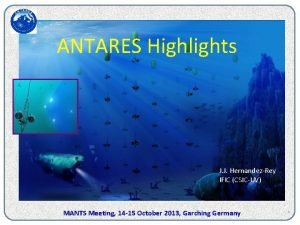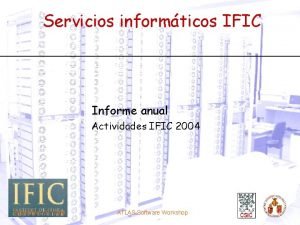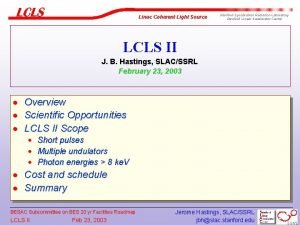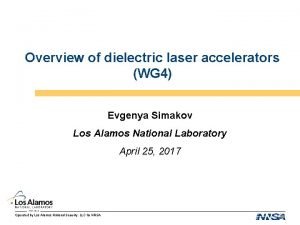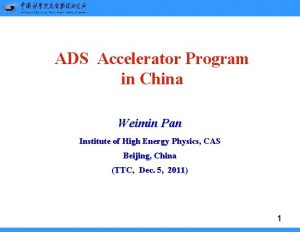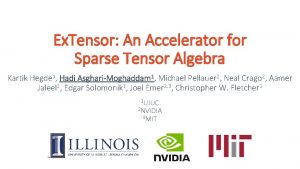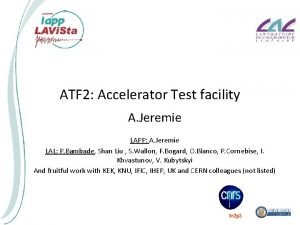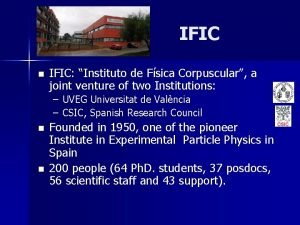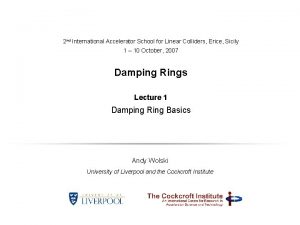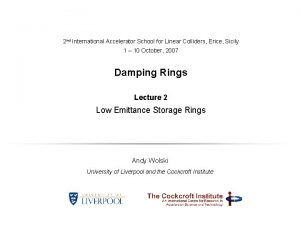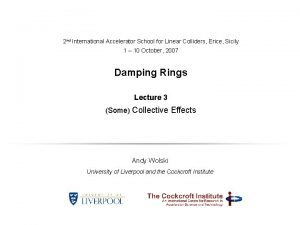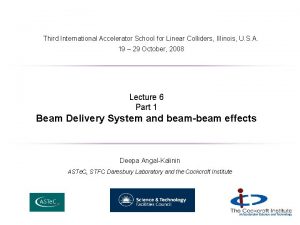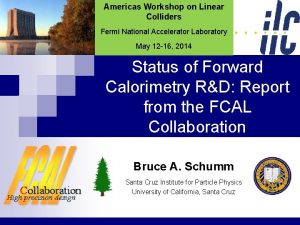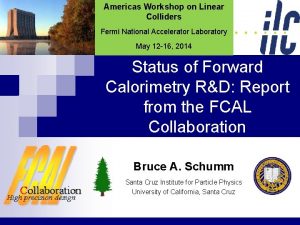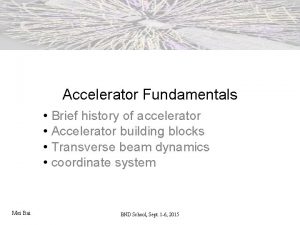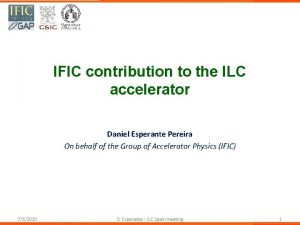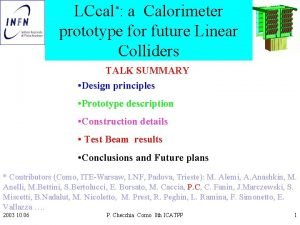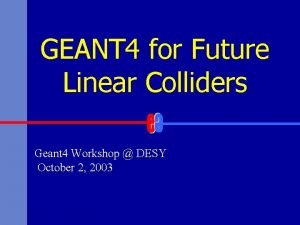Accelerator RD for Future Linear Colliders at IFIC




















- Slides: 20

Accelerator R&D for Future Linear Colliders at IFIC Scientific Staff: A. Faus-Golfe, C. Alabau, J. J. García, S. Verdu, J. Alabau Technical Staff: J. V. Civera, C. Blanch 7 -8 May ILC Spain 09 1

Capabilities BEAM INSTRUMENTATION : - CALCULATION ØElectromagnetic analysis • Electric circuits & electronics ØMechanical analysis BEAM DYNAMICS EXPERTISE: ØOptics design ØNon-linear dynamics studies ØNew instrumentation techniques ØCommissioning - PROTOTYPING ØDesign: tooling, drawings ØFabrication follow-up ØAssembly ØTesting 3 -D modelling ot BPM Optics study for LHC non-linear collimation sysytem 7 -8 May ILC Spain 09 2

Main ongoing projects ØATF-ATF 2: Beam dynamic studies and commissioning of the EXT line (LAL, KEK, SLAC) Instrumentation: New Multi-OTR system (SLAC, KEK) BPM supports with micromovers for FONT 4 (KEK, JAI) ØCLIC-CTF 3: BPM’s for TBL (UPC, CERN) Pieces of BPM-TBL for CTF 3 7 -8 May ILC Spain 09 3

Main Ongoing Projects: ATF and ATF 2: Emittance growth studies ATF was built in KEK (Japan) to create small emittance beams. The Damping Ring of ATF has a world record of the normalized emittance of 3 x 10 -8 m rad at 1. 3 Ge. V. ATF 2 is being built to study the feasibility of focusing the beam into a nanometer spot (~37 nm) in a future linear collider. Extraction line drives the beam from ATF to ATF 2 7 -8 May ILC Spain 09 4

ATF and ATF 2: the Extraction Line diagnostic section extraction wire scanners (OTR) OTR monitor The beam passes horizontally off-axis through the shared magnets with the DR Since several years, the vertical emittane measured in the diagnostic section of the EXT line is significantly larger than the emittance measured in the DR. Hypothesis: Non-linear magnetic fields while passing off-axis through the shared magnets 7 -8 May ILC Spain 09 5

ATF and ATF 2: Non-linear magnetic fields Computation of the non-linear magnetic fields of the magnets involved in the extraction with the code PRIAM BS 1 X septum magnet QM 7 R quadrupole At the extraction (x=2. 25 cm): Extracted beam Dipole component appears Polynomial fit of the magnetic field: Multipole coefficients: Quadrupole component reduced ~ 24% with respect to the DR Non negligible sextupole component ILC Spain 09 6

ATF and ATF 2: Tracking simulations including non-linear fields in different magnets of the extraction The non-linearity would have negligible effect if the beam were always centerd vertically, but increases when passing vertically off-axis through QM 7 R. The magnitude of the growth also depends on the horizontal displacement, increasing or decreasing in the outer and inner parts of the magnet. offset in QM 7 Experimental Proposal open the bump in DR and EXT Closed orbit bumps in the DR are used to deviate the extraction trajectory and study its correlation with the emittance growth 7 -8 May 7 close the bump in the DR OTR monitor

ATF and ATF 2: Experimental Work (Dec’ 07 -May’ 08) Measurements + simulatios for different horizontal extraction positions: Beam size at the OTR/XSR (28 th May’ 08) Beam size at the OTR/XSR (19 th Dec’ 07) Measurements during different shifts: - The results show an emittance growth with a strong dependence with the extraction position. 7 -8 May - But still there must be another source for the emittance growth since in three of the data sets the extracted beam was significantly larger than expected. It could be doe to an anomalous dispersion, a large horizontal displacement or to another mechanism. ILC Spain 09 8

ATF and ATF 2: Conclusions Simulations including the non-linear fields in the extraction region predict a significant vertical emittance growth while passing throug QM 7 R vertically off-axis. The magnitude of the growth depends on the horizontal displacement, since the non-linearity decreases going towards the center of the magnet. Measurements using closed orbit bumps in the DR to probe the relation between the extraction trajectory and the emittance growth were done: - The results show an emittance growth with a strong dependence with the extraction position. - But still there must be another source for the emittance growth since the extracted beam was significantly larger than expected in three of the data sets. Recently, the QM 7 R magnet was replaced by a similar one with larger aperture, for which magnetic measurements and simulations indicate that non-linear fields are negligible at the extraction position. 7 -8 May ILC Spain 09 9

Main Ongoing Projects: ATF and ATF 2: New Multi-OTR System diagnostic section wire scanners extraction (OTR) OTR monitor Emittance measurements with the wire scanners located in the diagnostic section of the EXT line are very slow. Proposal: Ømulti OTR (4 units) (in collaboration with KEK, SLAC): beam dynamics studies, design, construction, and characterization including associated electronics 7 -8 May ILC Spain 09 10

OTR 4 OTR 3 OTR 0 OTR 1 OTR 2 extraction OTR 1 X ATF and ATF 2: New Multi-OTR System diagnostic section The location of the OTR’s has to be optimized such that the phase advances be apropiate to allow emittance measurements 7 -8 May ILC Spain 09 11

ATF and ATF 2: New Multi-OTR System New design of the OTR for ATF-ATF 2 Current OTR installed in the ATF EXT line CCD camera target New OTRs will have same controls and motion capabilities as current OTR with the following improvements: - Target actuator relocated to the top (no interference with the girder) and smaller design greater flexibility in the OTR placement - Thinner target reduce radiation damage - CCD camera parallel to the target (before it was not parallel, which meant that the beam spot was in focus on only a small portion of the target) greater depth of field. - 12 bit camera for more dynamic range with smaller pixel size for more resolution. 7 -8 May 12

Main Ongoing Projects: ATF and ATF 2: BPM’s supports with micromovers for FONT 4 IP intra-train feedback system • • • Last line of defence against relative beam misalignment Measure vertical position of outgoing beam and hence beam-beam kick angle Use fast amplifier and kicker to correct vertical position of beam incoming to IR FONT – Feedback On Nanosecond Timescales 7 -8 May ILC Spain 09 13

ATF and ATF 2: BPM’s supports with micromovers for FONT 4 Proposal: ØBPM’s supports with micromovers for FONT 4 (in collaboration with KEK, JAI) design, construction, and characterization including associated electronics Realignment of BPM to increase the resolution Range: ± 1 mm Step size: 10 μm Stability better than 1 μm Time response ~ sec Planning: 1 st prototype for Dec’ 09 (ATF 2 shutdown) 7 -8 May ILC Spain 09 14

Main Ongoing Projects: CLIC-CTF 3: BPM’s for the Test Beam Line Ø 16 Beam Position Monitors for the TBL (in collaboration with UPC, CERN): designed, constructed, characterized and tested including supports and associated electronics The TBL is designed to study and validate the drive beam stability during deceleration in CTF 3. The TBL consists of a series of FODO lattice cells and a diagnostic section at the beginning and end of the line. Each cell is comprised of a quadrupole, a BPM (labeled as BPS) and a Power Extraction and Transfer Structure (PETS). 3 D View of a. TBL cell with the PETS tanks, the BPS’s and the quadrupoles BPS Prototype Inductive Pick-up (IPU) TBL beam time structure 2. 25 cm Inductive sensors PCB 15

CTF 3: BPM’s for the Test Beam Line BPS Prototypes A set of two prototypes of the BPS's labeled as BPS 1 and BPS 2 with its associated electronics has been designed, constructed and characterized by the IFIC team with the collaboration of the CTF 3 team at CERN. The characterization has been made with the wire method in the BIPI labs at CERN. This test is based on a test bench setup that allows moving the BPS with respect to a current wire that simulates the beam passing trough the BPS under test. From the point of view of the electronics two different versions of the PCB's, differing in the secondary output resistors used for the adjustment of the low-frequency cut-off, has been also tested. BPS 1 Prototype Performance BPS 1 Sensitivity and Linearity Parameters V Sensitivity, SV 41. 09 m-1 H Sensitivity, SH 41. 43 m-1 V Electric Offset, EOSV 0. 03 mm H Electric Offset, EOSH 0. 15 mm V overall precision (accuracy), σV (+/- 5 mm) 78 μm H overall precision (accuracy), σH (+/- 5 mm) 109 μm BPS 1 Characteristic Output Levels Sum signal level, Σ 16. 5 V Diff signals levels, ||ΔV||max, ||ΔH||max 8. 25 V Centered beam level, Vsec (x. V = 0, x. H = 0) 4. 125 V BPS 1 Frequency Response (Bandwidth) Parameters Σ low cut-off frequency, flΣ 1. 76 KHz Δ low cut-off frequency, flΔ 282 KHz Σ[Cal] low cut-off frequency, flΣ [Cal] 1. 76 KHz Δ[Cal] low cut-off frequency, flΔ [Cal] 180 KHz High cut-off frequency, fh > 100 MHz High cut-off frequency [Cal] fh[Cal] > 100 MHz BPS 1 Pulse-Time Response Parameters Σ droop time const, τdroopΣ 90 μs Δ droop time const, τdroopΔ 564 ns Σ[Cal] droop time const, τdroopΣ [Cal] 90 μs Δ[Cal] droop time const, τdroopΔ [Cal] 884 μs Rise time const, τrise < 1. 6 ns Rise time const [Cal], τrise [Cal] < 1. 6 ns The BPS 1 and its support is already installed in the TBL line. After the installation in March 2009 some preliminary test with beam has been performed. BPS 1 and its support installed in the TBL line Measurements of the BPS 1 with beam in the TBL line ILC Spain 09 16

CTF 3: BPM’s for the Test Beam Line BPS series production and characterization The series production of the 15 unit (BPS 1 + 15) have been started at the IFIC labs in November 2008. We have characterized two units: a refurbished version of the BPS 2 (PCB final version) and a new unit labeled as BPS 3. DAQ equipment for all the setup signals and micromovers controller The main features of this new test bench setup is that the BPS under test is moved by a motorized XY and rotatory micromovers to change the relative wire position with respect to the wire, and, moreover, the wire is fed with a higher current (>250 m. A) to avoid the low current effects in the test measurements. BPS 2 and BP 3 Series Performance Low-frequency wire set up at the IFIC labs 3 D view of the Low-frequency wire set up ILC Spain 09 Sensitivity and Linearity Parameters V Sensitivity, SV H Sensitivity, SH V Electric Offset, EOSV H Electric Offset, EOSH V overall precision (accuracy), σV (+/- 5 mm) H overall precision (accuracy), σH (+/- 5 mm) Characteristic Output Levels Sum signal level, Σ Diff signals levels, ||ΔV||max, ||ΔH||max Centered beam level, Vsec (x. V = 0, x. H = 0) Frequency Response (Bandwidth) Parameters Σ low cut-off frequency, flΣ Δ low cut-off frequency, flΔ Σ[Cal] low cut-off frequency, flΣ [Cal] Δ[Cal] low cut-off frequency, flΔ [Cal] High cut-off frequency, fh High cut-off frequency [Cal] fh[Cal] Pulse-Time Response Parameters Σ droop time const, τdroopΣ Δ droop time const, τdroopΔ Σ[Cal] droop time const, τdroopΣ [Cal] Δ[Cal] droop time const, τdroopΔ [Cal] Rise time const, τrise Rise time const [Cal], τrise [Cal] BPS 2 43. 16 m-1 44. 60 m-1 -0. 67 mm 0. 50 mm 89 μm 90 μm BPS 3 43. 70 m-1 42. 10 m-1 -0. 84 mm 0. 52 mm 94 μm 98 μm 16. 5 V 8. 25 V 4. 125 V 2. 90 KHz 1. 70 KHz 271 KHz 275 KHz 2. 80 KHz 1. 70 KHz 163 KHz 171 KHz > 100 MHz 55 μs 587 ns 57 μs 976 μs < 1. 6 ns 93 μs 579 ns 93 μs 931 μs < 1. 6 ns 17 < 1. 6 ns

CTF 3: Conclusions The series production of 15 units has already started. The production of the different parts is finished. One unit of the series: BPS 3 was assembled. After the characterization test made at IFIC labs in a new wire low-frequency setup, it was shipped to CERN jointly with BPS 2 and its corresponding supports. These two units are being installed in the TBL line. The rest of the series will be installed in July 2009. Furthermore a high frequency setup for measuring the longitudinal impedance is being constructed at IFIC. The measurements will be made during May with some of the units of the series. 7 -8 May ILC Spain 09 18

Main Future projects ØILC: BDS instrumentation studies ØLHC: non-linear collimation options for s. LHC (SPS experiments) (EUCARD) ØIFIMED: Imaging and Accelerators applied to Medicicine • Monitoring of secondary beams (beam position and size) (CERN; LLR, CNAO) • Cyclinacs applications (TERA, CTF 3) 7 -8 May ILC Spain 09 CABOTO: Carbon Boster for Therapy in Oncology 19

Thanks for your Attention 7 -8 May ILC Spain 09 20
 Future perfect by the time
Future perfect by the time Future perfect simple and future continuous exercises
Future perfect simple and future continuous exercises Br ific
Br ific Br ific
Br ific Horde csic
Horde csic Stanford linear accelerator tours
Stanford linear accelerator tours Stanford
Stanford Future nurse programme
Future nurse programme Future continuous and future perfect
Future continuous and future perfect Future plans and finished future actions
Future plans and finished future actions The perfect future tense
The perfect future tense Present continuous tense and past continuous tense
Present continuous tense and past continuous tense Nulti i prvi kondicional
Nulti i prvi kondicional Rules of tense
Rules of tense Travel present continuous tense
Travel present continuous tense Future perfect and future continuous examples
Future perfect and future continuous examples Summary tenses
Summary tenses Dielectric wall accelerator
Dielectric wall accelerator Ads accelerator
Ads accelerator Extensor: an accelerator for sparse tensor algebra
Extensor: an accelerator for sparse tensor algebra Accelerator
Accelerator



